
100 Bullets: The Rain
April 22nd, 2009 Posted by david brothersImages in this post from Six Feet Under the Gun, Samurai
, The Hard Way
, and Strychnine Lives
.
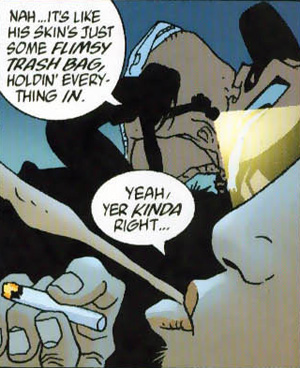
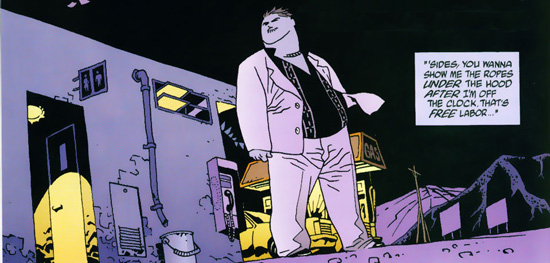
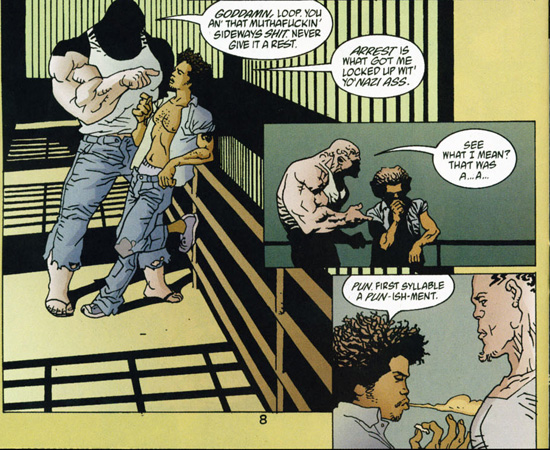
Read the rest of this entry �

Images in this post from Six Feet Under the Gun, Samurai
, The Hard Way
, and Strychnine Lives
.




Images from this post from A Foregone Tomorrow, The Counterfifth Detective
, and Six Feet Under the Gun
.
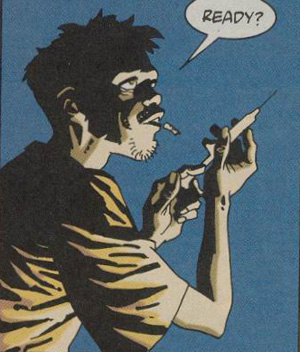
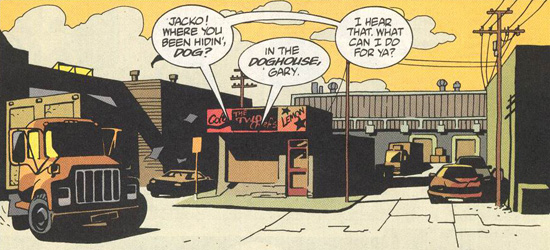
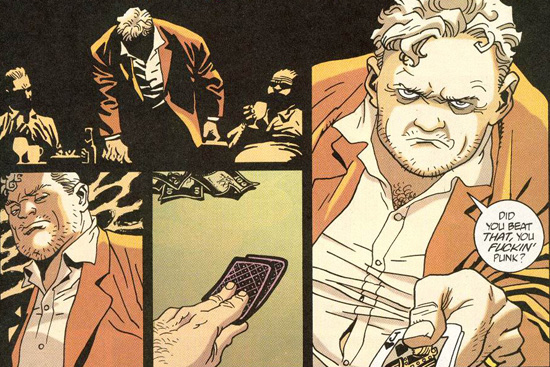
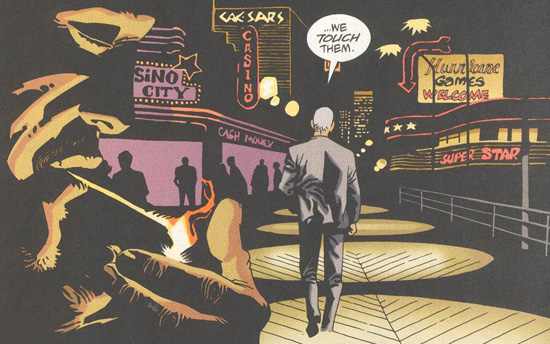


I keep trying to think of an appropriate goodbye for 100 Bullets.
In the past year, I’ve lost The Wire, The Shield, and Garth Ennis’s Punisher MAX. After this past Wednesday, 100 Bullets is gone, too. That’s four great pieces of crime fiction, or noir, or whatever, gone in just under a year. It sucks, but they all got to tell their story to the very end. 100 Bullets is probably my favorite of the four, or at least it is right now, and I have this driving need to pay homage to it somehow.
An issue-by-issue, or trade-by-trade, retrospective sounds so unbearably pat and boring that I just can’t do it. I wouldn’t get anything out of it, and neither would you. I think instead, I’m going to do something different from what I usually do.
100 Bullets, 100 moments. I’ve said before that many moments from 100 Bullets stick out in my memory. I skimmed through all 100 issues and found 100 moments I thought I’d share.
The twist is that these aren’t going to be your usual scans_daily-style “Aw man that rules look how awesome that dude is there doing that awesome thing.” 100 Bullets excels in that Azzarello’s words, Risso’s art, and Mulvihill’s colors mesh into an amazing thing. They build characters, whether that character is a person or a city or a car. The storytelling comes from an odd angle, whether it’s from above meathooks or beneath a table.
So, here’s the plan. Five days. Twenty moments a day. I say moments, as there are a few that are full pages, but most of these are just single panels. I’ll put links at the top for the trades represented, but no commentary is coming otherwise. Just panels, posted in chronological order, that show the team at work. There will be cursing, maybe some violence, who knows.
Fans feel free to chime in down in the comments. I’m sure that a lot of these will kick up memories for you. On Saturday, I’m going to do my big 100 Bullets post to close out the week. If you don’t know 100 Bullets, this won’t spoil much, if you care about that kind of thing.
Ten new headers are up, too, to commemorate 100 Bullets week. Check out the whole series on Amazon here, and I’ll catch you in the morning.

Brian Azzarello and Eduardo Risso’s 100 Bullets #100 drops today, and it’s the end of the series. I’m planning on picking my copy after work.
I’m kind of sad about it, but a different kind of sad than I was when I finished the first issue of Flash: Rebirth. Rebirth was a signal that the DC Universe is moving in a direction that is pointedly Not For Me. The end of 100 Bullets is the end of a series that was definitely, 100%, absolutely aimed directly at my temple.
100 Bullets started before I got back into comics, and to be honest, I’m not sure exactly when I started it. I think it’s Thomas Wilde’s fault, and skimming covers and wracking my brain leads me to believe that I began picking it up regularly during the Chill in the Oven arc, mid-2003. I know that I read the first arc, then Counterfifth Detective, and then started over again from the beginning.
Since then, I’ve bought every issue and every trade, something I rarely do. Double-dipping is a sucker’s move, but I dig the series enough that I didn’t mind paying twice. While looking over the covers, I was struck with memories ofa series of moments from the series. The Saddest Thing in the NOLA arc, Cole’s one-shot, the peckerwood joke in Chill in the Oven, the history lesson in issue 50, Lono and Loop’s discussion of the d-spot, Victor Ray indulging himself on a mission by doing the Frank Castle thing, Graves losing it when someone important dies, Dizzy’s ascendance, Lono’s look as he realizes that he killed a friend, the teenage pregnancy drama that plays a background role to Graves telling a mother exactly why her daughter died, Remi Rome going from amazing character to my most hated and back around again, the way that Loop’s dad was Mr. Hughes to the Minutemen, never ‘Curtis.’ Dave Johnson’s amazing covers.
These are just moments in the series. The moments build to the story arcs. Dizzy going from hood rat to high class. Loop learning how to be a man via Graves’ guilt over how Loop’s father was treated. The reconnection and dissolution of the Minutemen once again. The fall of the Trust.
It’s a series I’m very fond of, and was hands-down the best comic of the week each and every time. It’s one that rewards repeat readings, and even readings where you skip all of the words and just take in Eduardo Risso’s art. It made me a believer in Vertigo in a way that Sandman and the rest of the boring fantasy books that’d previously made up the bulk of Vertigo didn’t.
100 Bullets was, for me, a Thing. It’s the only comic I’ve bought for six years straight, month-in, month-out. It was my only mainstay, and now it’s gone. I think the comics world will be poorer without it. I can’t think of a comic I’ve enjoyed as consistently as 100 Bullets. I can’t even think of a creator who’s delivered as consistently as Azz and Risso have.
100 Bullets is The Symphony. It’s talented creators dropping in, doing some amazing work, and dropping out, leaving the track, or the genre, or the industry, or their peers, a drooling and shuddering mess. It’s Wu-Tang Forever, with RZA’s arrogant insistence at the end of Bells of War, halfway through Disc Two, that Wu-Tang Forever is so ahead of its time that “niggas ain’t gonna figure it out til the year Two-G.” It’s Raekwon on The Closing on the same record, explaining that he looks at other emcees and realizes that they’re going to stay garbage because they don’t know any better.
Azzarello and Risso’s 100 Bullets is a challenge. It’s saying, “Look, we did this. This is us. Ante up.”
I’ll be sorry to see it go. I keep thinking that I want to do this big, bang-up, blow-the-doors-off outrospective, but I don’t even know if I know where to start or if I even should. Luckily, Tucker’s got an Off the Shelf for us, and I hope to see Matthew Brady writing about it, too. I really enjoyed his Monster series, though I don’t think I ever remembered to link to it, and I know he’s a fan. I’m curious to see what kind of send-off the best comic book to come out of Time Warner will receive.
100 Bullets is 13 volumes, and pretty cheap on Amazon. You can catch each volume for around ten bucks new, less from a third-party seller. In fact, the first book’s like five bucks right now. Links below. If you haven’t started, you should. I’m not at all exaggerating when I say that it’s easily my favorite comic, and one of the most rewarding I’ve ever picked up. Click here to look at the entire 100 Bullets catalog on Amazon.

On Illmatic, Nas breaks off the intro to N.Y. State of Mind to say, “I don’t know how to start this.” There’s a pause, and with a “yo,” he goes on to kick five minutes of sublime lyrics. It’s not a studio gimmick or a punch-in. It’s real life. This little snippet of time, maybe three seconds at most, is Illmatic in miniature. It’s the biography of the young black male: simultaneously brilliant and unsure, arrogant and nervous, full of potential and lacking at the same time.
It’s a line that brings to mind Loop Hughes of 100 Bullets. Before the events of the series, he was the son of a single mother, running with faceless nobodies, and drifting through life. He had a life, but it was half of one. He was going nowhere.
Eventually, he meets his father, thanks to a nudge from Agent Graves, and that puts him on some kind of a road. He absorbs knowledge and experience from his father like a sponge. After his father dies, he learns that his father was respected a great deal by hard men, and he learns another lesson.
Over the course of the series, Loop pays attention to things and keeps learning. He’s trained in prison by a man with no conscience, and when they get out, he’s connected to more men who knew his father. As time goes on, he learns about life and killing. He’s a sponge.
Finally, toward the end of the series, he’s in a situation that is the ultimate mexican standoff. Two of the men involved have no interest in solving it any way but one. Loop sees another solution and takes it, trusting that things will align as they should. And they do. It’s another Illmatic line. “Whose world is this? The world is yours, the world is yours.”
There’s a lot that I like about Loop, and a lot that I can relate to. I know about having a single mother. I know about being aimless. I know about needing a push to reach greatness. I can identify with Loop’s rise over the course of 100 Bullets, because it resembles my own.
Illmatic’s message is, at least in part, about potential. You are sitting at the top of a hill and full of potential energy. You can either waste that energy and fall, or you can spend it and soar. The thing that I, and a lot of people like me, understand is that the potential within me is limitless. The older I get, the more I realize I can do. Everything I’ve ever decided to do, I’ve done and done well. When someone asks me “Whose world is this?” the only appropriate response is “It’s mine, it’s mine, it’s mine.”
At the same time, that arrogance only goes so far. Sometimes you have to sit back and whisper, “I don’t know how to start this.” You start out on the back foot, so you’ve got to worry about how you look to others and make sure that you’re on point. The moment you screw up, you become a statistic, a stereotype, typical, and generally just another reason for people to go “Ugh, I knew it.” There’s that little voice in the back of your head that says that you aren’t good enough, and never will be.
Once you get past that, the world is yours.
Loop’s been on my mind a lot lately, for both the reasons I mention above and the fact that 100 Bullets is about two weeks away from ending as I type. When I went to New York Comic-con, I had a chance to get a sketch from Eduardo Risso, artist of 100 Bullets. I thought about it for a moment and realized that I needed a sketch of Loop. So I got it.

I’m very picky about what I put up on my walls. It’s got to have some special meaning to me or represent something, rather than just being a hot piece of art. Ali is the arrogance that is necessary, John Henry is about purpose and drive, and Loop is about potential.
It’s 2009. I’m 25 years old, and the world is mine.

I don’t “get” the Joker. I know he’s Batman’s greatest villain, but I don’t exactly understand why. I find Riddler infinitely more interesting, and think that he’d be a great foil for a man who honed his mind and body into the peak of human condition or whatever.
Anyway, the Joker is the epitome of my problem with Batman’s villains. He’s ca-razy, coocoogococonuts, and insane. He does what he does because he hates Batman, or loves him, depending on your interpretation. That’s basically my least favorite motivation for a villain. At least Lex Luthor believes in the inherent superiority of mankind (Luthorkind). Joker just wants to be crazy.
Luckily, this is comics and there are a number of different Jokers I can pick from. The Joker Alan Davis wrote in The Nail was singularly spiteful, and the end point of where I see the “regular” Joker going.
 I really, really like Dandy Joker, as played by Cesar Romero in Batman or my good friend Emily Stackhouse of Writer’s Old Fashioned. You can actually see everything I love about Dandy Joker in her pose. It’s relaxed, fun, and most of all, funny. This Joker does things because it is hilarious. Acid in the face? Joker fish? It is all good, it is all in fun, and if a few dozen people die during it… that’s even funnier. Man falls down and sprains his ankle? Sad. Man falls down a manhole? Funny. Man falls down a manhole into a sewer full of grinning crocodiles painted like clowns and dressed like the Daughters of the American Revolution?
I really, really like Dandy Joker, as played by Cesar Romero in Batman or my good friend Emily Stackhouse of Writer’s Old Fashioned. You can actually see everything I love about Dandy Joker in her pose. It’s relaxed, fun, and most of all, funny. This Joker does things because it is hilarious. Acid in the face? Joker fish? It is all good, it is all in fun, and if a few dozen people die during it… that’s even funnier. Man falls down and sprains his ankle? Sad. Man falls down a manhole? Funny. Man falls down a manhole into a sewer full of grinning crocodiles painted like clowns and dressed like the Daughters of the American Revolution?
That’s amore.
This brings me around to Brian Azzarello and Lee Bermejo’s Joker. I’m not really here to review it, other than to say that I enjoyed it like I’ve enjoyed Azz’s other work, but the Joker they portrayed was really interesting to me.
Instead of being the invincible super crazy clown prince of crime, Azz’s Joker is a broken man. He refers to his years in Arkham as the time he was “gone,” and seems hesitant to say that he is crazy. Other people believe he’s crazy, but the only ones that knows the truth are the narrator of the book and Joker’s silent Gal Friday, Harley Quinn.
There’s a scene in the book that solidified my feelings about the Joker in general. The narrator is walking past the Joker’s room, and he sees Joker collapsed on the ground, hugging Harley Quinn, and just going to pieces. This is a Joker I like. He isn’t superhuman. He knows exactly what he’s doing. But, he’s trapped in a prison of his own design.
My idea about this is that the Joker got stuck in his own gimmick. At first, he’d do something crazy to get someone off his back. It was so outlandish and insane that he had to keep it up, or else people would know he was soft. And when you’ve made a living out of being the hardest man around… you can’t afford that.
So, he’s trapped. He can never escape, because escaping means it’s game over. At the same time, Batman is the only one who can save him. The Joker does all this stuff to get Batman’s attention to be put back into jail and away from a place where he has to keep up the facade.
I kind of like a pathetic Joker. It isn’t something I’d like to see always, but it’s a very human and believeable take.
As far as silent moll Harley Quinn goes… wow! I didn’t think I’d dig the take, but it worked out really, really well. In a way, she was one of the most threatening people in the book, and I think it’s because she never spoke. She’s that Stand By Your Man girl. She’s there for support, and sometimes support means machinegunning a dozen people and skinning a man alive. It’s a little scary, and the silence means we get no insight into her character. We just know she likes luxury and stands by the Joker, no matter what. I’m such a stan for Harley, though.
Like I said, nothing I want to see constantly, but a fun little peek into an alternate take. Frank Miller’s not-funny Joker in ASBAR was another one I liked, because it made super murderous Joker into something inhuman, interesting, and actually kind of scary, if more than a little overwrought.
I’d love it if Genocidal Kills a Thousand People a Day Joker retired forever. It’s by far my least favorite Joker, and the least original take on the character I can think of. I like a Joker that goes deeper than just “Waheyhey CRAZY! BY THE WAY I JUST KILLED A MILLION PEOPLE BATMAN WHATCHA GONNA DO HUH?”
At that point, Batman should just take one for the team and give Joker accidentally beat Joker until nothing’s left but a puddle of blood. That Joker isn’t doing anything but hurting Batman as a character. Someone break his neck or toss him down a deep hole or just shoot him in the face, seriously.
And let the Riddler take his place.
(what kind of world is it where i’m the guy wanting less murders in comics?)


Done by what could’ve been the sickest team on Earth?
Can you say “Brian Azzarello,” “Paul Pope,” and “Kamandi?”
Well, you almost did, but Pope went on to do Batman Year 100 and Azz to do Loveless.
Paul Pope’s Flickr. Take a look around.
Here is a very un-Pope Wonder Woman, save for the lasso. A very Pope Big Barda.

David Mack, Jim Lee, Frank Miller, Grant Morrison, and Brian Azzarello are basically my five favorite comics creators.
Newsarama’s got previews up featuring three out of the five, and that ain’t half-bad.
Batman 666 and All-Star Batman 6 with a handful of pages a piece. Looking good. When’s the last time Barbara Gordon was this adorable? I think it’s the freckles, maybe. She actually looks like a gangly teenager.